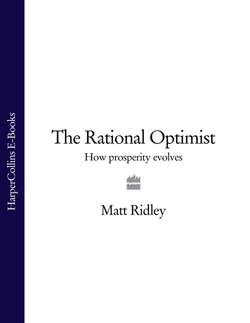Читать книгу The Rational Optimist: How Prosperity Evolves - Matt Ridley, Matt Ridley - Страница 27
Networking in the near-east
ОглавлениеThe lesson is stark. Self-sufficiency was dead tens of thousand years ago. Even the relatively simple lifestyle of a hunter-gatherer cannot exist without a large population exchanging ideas and skills. The importance of this notion cannot be emphasised too strongly. The success of human beings depends crucially, but precariously, on numbers and connections. A few hundred people cannot sustain a sophisticated technology: trade is a vital part of the story.
Vast though it is, Australia itself may have suffered from this isolation effect. Recall that it was colonised 45,000 years ago by pioneering beachcombers spreading east from Africa along the shore of Asia. The vanguard of such a migration must have been small in number and must have travelled comparatively light. The chances are they had only a sample of the technology available to their relatives back at the Red Sea crossing. This may explain why Australian aboriginal technology, although it developed and elaborated steadily over the ensuing millennia, was lacking in so many features of the Old World – elastic weapons, for example, such as bows and catapults, were unknown, as were ovens. It was not that they were ‘primitive’ or that they had mentally regressed: it was that they had arrived with only a subset of technologies and did not have a dense enough population and therefore a large enough collective brain to develop them much further.
The ‘Tasmanian effect’ may also explain why technological progress had been so slow and erratic in Africa after 160,000 years ago. It explains the periodic bursts of modern tools found at South African sites like Pinnacle Point, Blombos Cave and Klasies River. Despite the invention of exchange, the continent was like a patchwork of virtual Tasmanias. As Steve Shennan and his colleagues have calculated, whenever the right combination of (say) seafood, freshwater and fertile savannahs produced local population explosions, technology would have grown sophisticated in proportion to the number of people networked by exchange to sustain and develop it – in proportion to the scale of the collective intelligence. But when a river dried up or deserts advanced and human populations collapsed or shrank, technology would simplify again. Human cultural progress is a collective enterprise and it needs a dense collective brain.
Thus the extraordinary change in technology and cultural tradition that seems to have flourished more than 30,000 years ago in western Asia and the Near East – the so-called Upper Palaeolithic Revolution – may be explained by a dense population. Fed by an increasingly intensive and vegetarian hunter-gathering lifestyle, and with close contact between tribes, the people of south-west Asia were in a position to accumulate more and more skills and technologies than any previous human populations. A large, interconnected population meant faster cumulative invention – a surprising truth even to this day, as Hong Kong and Manhattan islands demonstrate. As the economist Julian Simon put it, ‘population growth leading to diminishing returns is fiction; the induced increase in productivity is scientific fact’. And one of those inventions was farming, which is the subject of the next chapter.
It is right to end the hunter-gatherer chapter, though, by remembering what happened to the Tasmanians. In the early 1800s, white sealers began to arrive along the island’s coasts and it was not long before the Tasmanians were eagerly meeting the sealers to trade with them, proving that 10,000 years of limited exchange had done nothing to dampen their innate enthusiasm for barter. The sealers’ dogs were especially sought after, being deerhounds that could easily run down kangaroos. In exchange, sad to relate, Tasmanians sold women to the sealers as concubines. Once white farmers arrived, relations between the two peoples deteriorated and eventually the whites sent bounty hunters to kill the natives, then rounded up the survivors and exiled them to Flinders Island, where they eked out their last days in misery.
